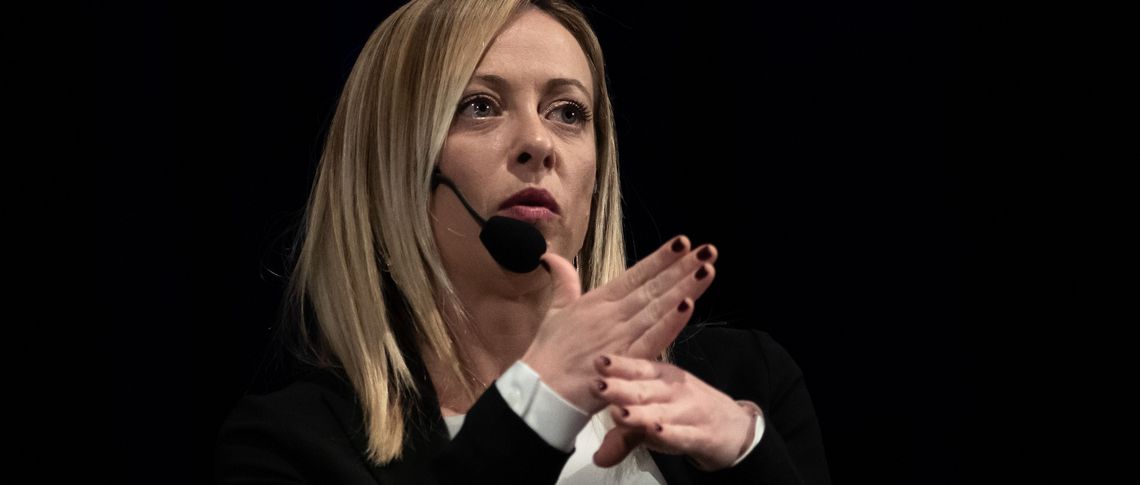As any good history book will tell you, Italian fascism ended in the final days of April 1945. On 27 April, Benito Mussolini’s entourage was stopped near the town of Dongo by communist partisans who shot the Duce and his lover Clara Petacci, brought the corpses to Milan and hung them upside down from the roof of a petrol station. Just a few days later, Defence Minister Rodolfo Graziani capitulated with the remaining armed forces, thus ending the brief existence of the Salò Republic, set up in 1943 as a German puppet state, which, decades later, would serve Pier Paolo Pasolini as the historical setting for his adaptation of The 120 Days of Sodom. A period of upheaval followed: abolition of the monarchy, constitutional reform, European integration.
But as ideologies never want to die completely, ostracised, fascism soon returned in the shape of neo-fascism. But here, the difference was evident: the former mass movement had shrunk into a diffuse collection of groups and factions unable to get a leg on the ground in Italian post-war parliamentary politics, which is dominated by the Democrazia Cristiana. In any case, the communists increasingly became the troublemakers in the young republic, murdering former Prime Minister Aldo Moro during the Years of Lead, when right-wing and left-wing terror continuously alternated.
Gianfranco Fini, who first de-ideologised the Movimento in the 1990s, was labelled ‘post-fascist’. Fratelli chairperson and Prime Minister Giorgia Meloni is now experiencing a similar situation.
A real relaxation of tension came only with the collapse of the Soviet empire, bringing Italy closer to Western Europe’s ideological normality; no matter how wobbly the party-political constellations (the Democrazia Cristiana dissolved itself in 1994, to be functionally replaced by the Popolo della Libertà of the recently deceased Silvio Berlusconi), there was a right and a left centre fighting for the office of prime minister. And a few smaller parties that supported them as and when they thought fit.
From 2010 onwards, the Roman political roundabout once again started revolving faster. First the Monti technocratic cabinet installed in the wake of the euro crisis, then the rise and fall of the Five Star Movement and the Lega and, finally, in 2022, the triumph of a force that had previously been in the low single-digit percentage range: the Fratelli d'Italia. Less than 10 years old at the time, this party already enjoyed a certain dubious reputation due to its positions and a history stretching back from the Alleanza Nazionale and the Movimento Sociale Italiano to the neo-fascism of the post-war period.
Fascist, post-fascist, or maybe neo-fascist?
Gianfranco Fini, who first de-ideologised the Movimento in the 1990s and then transformed it into the Alleanza, was in his day labelled ‘post-fascist’. Fratelli chairperson and designated Prime Minister Giorgia Meloni is now experiencing a similar situation. The whole world was quickly talking about the Roman politician’s sinister references to the past and indulging in dark premonitions.
In the case of the Fratelli, there is also the unpleasant suspicion that the label serves primarily for purposes of delegitimisation and seems to be considered optional in many places.
This judgment is scarcely questioned, despite containing certain weaknesses that, with a little distance, could also be described as defects. Because ‘post’ (unlike ‘neo’) initially only refers to a coming-after position and can also, depending on the context, indicate a departure. One example is the term ‘postmodern’, which, as is well known, aims at overcoming modernity and its belief in progress. To say that a party is post-fascist simply means that there was at some point a reference to fascism, but that this is no longer of the essence — at least not in a form that would justify continuing to attach this name to it. This may well be interesting from the perspective of the history of ideas, but for real political analyses, it is not much of a board to stand on. It would be more productive to ask what role the party in question plays in the political system, who votes for it and how suitable it is as a coalition and government partner.
In the case of the Fratelli, there is also the unpleasant suspicion that the label serves primarily for purposes of delegitimisation and seems to be considered optional in many places. ‘A post-fascist is lulling Europe’, warned Oliver Meiler in a Süddeutsche Zeitung article about Meloni, adding in a whisper that one should not be deceived by her supposed harmlessness; ‘the flame of fascism is still burning’. According to the subtext, the prefix is basically dispensable. It is just a mask, behind which, upon closer inspection, the same old abyss of longing for the past opens up.
The taz is less subtle, dismissing the situation completely with a dramatic evocation of Italian ‘girl boss fascism’. One, two, three — and the misty post-fascism, which no one can really define, becomes steely contemporary fascism, and the Fratelli the latest incarnation of Mussolini’s Partito Nazionale Fascista.
A government like any other?
Admittedly, such conceptual twists are hardly surprising, as the accusation of fascism is currently experiencing a veritable renaissance across the board. In the US, Donald Trump has been labelled a fascist since his first obscenity. But he enjoys playing the ball back, regularly criticising the fascists who attack him. The situation is not much different on the old continent, where ‘fascist’ has become a commonplace marker, pure negativity cast in word form that rounds off the varied brew of populisms, nationalisms and authoritarianisms.
Such all-purpose use is rarely effective. Rather, the too careless handling of the term is ‘not only counterproductive but also ignores historical facts’, as Michael Bröning put it in a clever commentary at the beginning of the year. Because ‘how can anyone be a fascist if everyone is?’ And no one takes seriously an accusation that must appear to outsiders either as an exaggeration or as a blow below the opinionated belt.
If Meloni succeeds in ensuring stable, conflict-free governance on the Apennine Peninsula in the future, she could ultimately prove an unexpected gain.
Taking stock after a year of ‘post-fascism’ in power, one is forced to conclude that there are still no grim Fratelli blackshirts marching down the streets of Rome. Instead, the Meloni government is mainly doing what one might expect from any other centre-right alliance in the absence of a Christian Democratic alternative: working on structural reforms, introducing financial relief for small businesses and cutting social welfare expenditure, unleashing counterfire on industrial policy at the EU level and stepping on its French neighbour’s toes.
When it comes to the Ukraine conflict, despite all concerns about the head of government’s supposed ‘Russophilia’, there is exemplary solidarity. And when it comes to the issue of refugee migration, a restrictive course is indeed being pursued, but not with the zeal of the Conte era, when Matteo Salvini, who has since been relegated to the infrastructure and transport department, waged an almost endless private war with various sea rescue organisations.
Against this background, instead of talking of a fascist demon in a post-fascist guise, it would be better to speak of business as usual, under a prime minister who is anything but the blunt Europhobe that she is often exaggeratedly portrayed as. Rather, she knows how to win people over with the same mixture of folksiness, agility, toughness and instinct that made Berlusconi the stand-up man of the Italian party system. Of course, this is not to everyone’s liking, especially not those who would rather have a hulking radical in power to confirm their own world view.
Europe’s overarching interest has to lie in having stable, low-conflict governance on the Apennine Peninsula. If Meloni succeeds in ensuring this also into the future, it could ultimately prove an unexpected gain. And possibly provide for a little less ideological heavy breathing.






